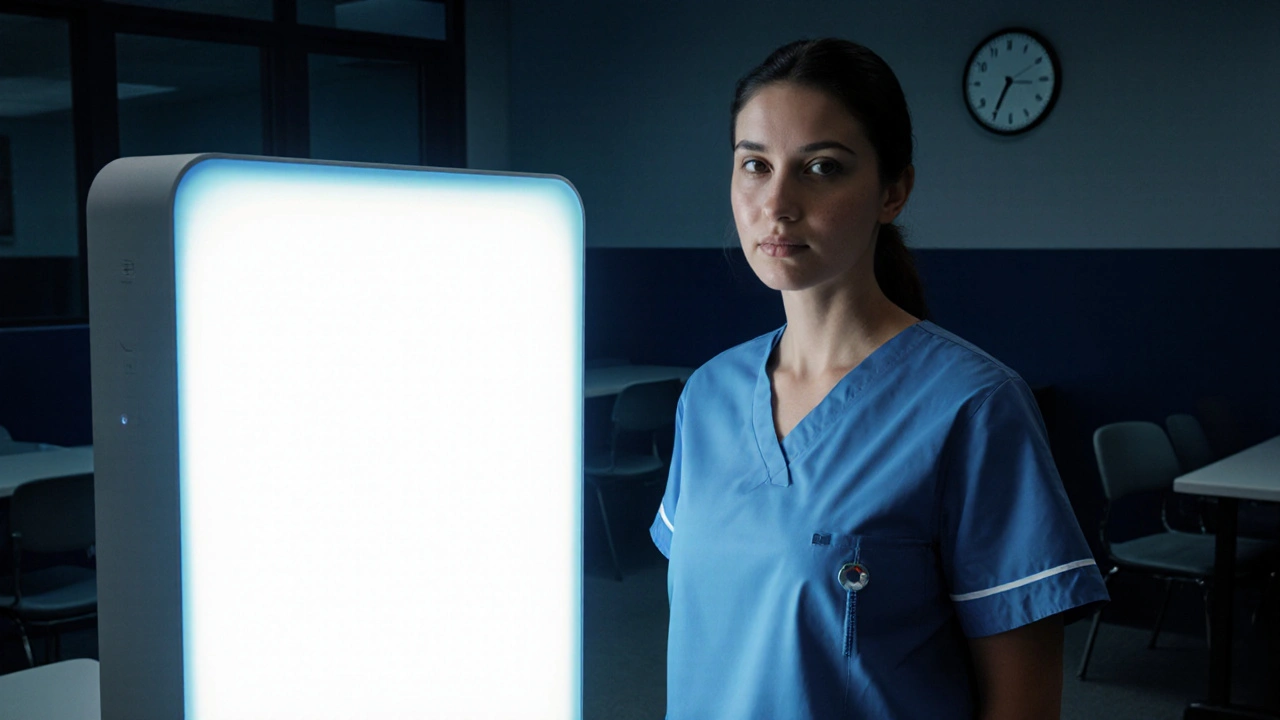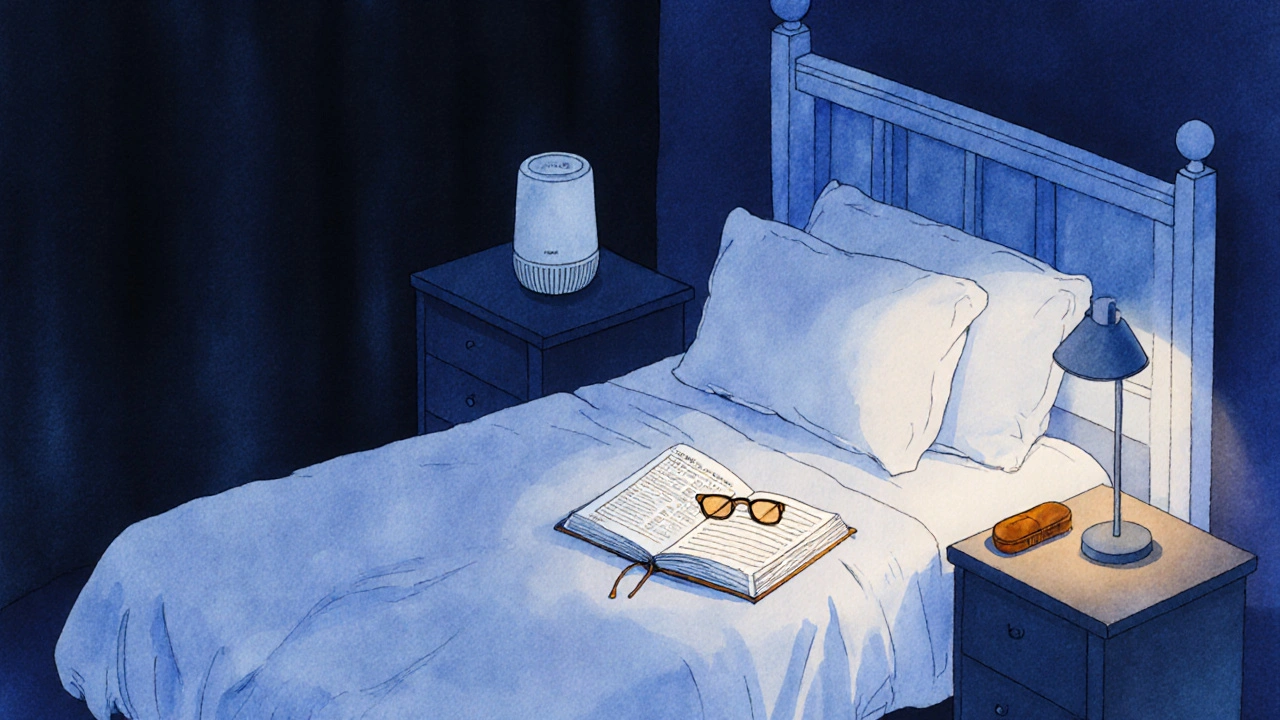Shift-Work Disorder: Proven Strategies to Cut Night Shift Fatigue

Shift-Work Fatigue Reduction Planner
Select Your Top Strategies
Bright Light Therapy
Use a 10,000 lux light box for 20-30 minutes at shift start to reset your internal clock.
Strategic Napping
Take a 20-minute power nap mid-shift or a 90-minute nap before shift to boost alertness.
Dark Sleep Environment
Create a dark, cool sleep space with blackout curtains and white noise to improve sleep quality.
Chronotype-Based Scheduling
Align your work schedule with your natural alertness patterns (lark, owl, or intermediate).
Caffeine Timing
Time caffeine intake to maximize alertness and minimize disruption to sleep.
Your Personalized Fatigue Reduction Plan
Effectiveness Overview
Key Takeaways
- Identify the core drivers of Shift-Work Disorder and how they fuel fatigue.
- Apply three sleep‑hygiene habits that fit any rotating schedule.
- Use bright‑light exposure and strategic napping to realign your internal clock.
- Match shift times to your personal chronotype whenever possible.
- Talk to your employer about policies that support healthier night‑shift patterns.
What is Shift-Work Disorder?
When you first heard the term Shift-Work Disorder is a circadian‑rhythm sleep disorder that affects people who work non‑traditional hours, especially night shifts, you probably imagined occasional tiredness. In reality, the condition can lead to chronic insomnia, excessive daytime sleepiness, and a cascade of health problems ranging from metabolic imbalance to mood disturbances.
The disorder stems from a mismatch between the body’s internal clock-known as the circadian rhythm-and the imposed work schedule. When your brain expects darkness but you’re under fluorescent lights, hormone signals go haywire. Two hormones are especially relevant:
- Melatonin-the sleep‑inducing hormone-drops when bright light hits the retina.
- Cortisol-the stress hormone-peaks at the wrong time, keeping you jittery.
Understanding this biology is the first step toward beating night shift fatigue.
How Fatigue Builds During Night Shifts
Four forces conspire to drain you:
- Light exposure: Artificial light suppresses melatonin, tricking the brain into thinking it’s daytime.
- Social pressure: Friends and family operate on a day‑time schedule, pulling you away from restorative sleep.
- Meal timing: Late‑night eating disrupts glucose regulation and can keep you alert when you’d rather be asleep.
- Physiological inertia: Your body’s core temperature, heart rate, and hormone output naturally rise in the evening, making sleep onset difficult.
When these factors repeat night after night, the brain’s alertness system stays on high alert, and the body never fully recovers.
Sleep‑Hygiene Practices That Actually Work
Good sleep hygiene is more than “go to bed early.” For shift workers, the rules shift a bit.
- Create a dark sleep environment-use blackout curtains, eye masks, and a white‑noise machine to mimic nighttime.
- Keep the bedroom temperature around 18‑20°C (65‑68°F) to support the natural drop in core body temperature that precedes sleep.
- Avoid screens for at least 30minutes before trying to sleep; if you must use a device, enable the blue‑light filter.
- Reserve the bed for sleep only-no work emails or TV. This trains the brain to associate the mattress with rest.
Following these steps can cut sleep onset latency by up to 25% in night‑shift employees, according to a 2023 occupational health study.
Light Management: Bright‑Light Therapy and Darkness Hacks
Because light drives the circadian rhythm, manipulating exposure is a powerful lever.
- Bright light therapy-using a 10,000‑lux light box for 20‑30minutes at the start of the night shift-helps shift the internal clock forward.
- Wear amber‑tinted glasses on the way home to block blue wavelengths, preserving melatonin production for the daytime sleep period.
- If a light box isn’t feasible, position yourself near a sunny window during the early part of the night shift; natural light is even more effective.
Research from the Sleep Medicine Society (2022) shows that consistent bright‑light exposure reduces subjective fatigue scores by 30% after two weeks.

Strategic Napping and Caffeine Timing
Short naps can be a lifesaver, but the timing matters.
- Aim for a 20‑minute “power nap” mid‑shift (around 3-4hours into the night). This restores alertness without entering deep sleep, which can cause grogginess.
- If your schedule allows, a 90‑minute nap before the shift starts helps you complete a full sleep cycle, improving cognitive performance.
- Use caffeine strategically: a 100mg dose (about a cup of coffee) 30minutes before the nap can boost the nap’s restorative effect, but avoid caffeine within 4hours of your intended sleep time.
These tactics are backed by a 2021 field trial in a hospital setting where nurses reported a 45% drop in self‑rated error rates after implementing timed naps.
Match Your Work to Your Chronotype
Not everyone’s body is wired the same. Your chronotype-whether you’re a morning lark, an evening owl, or somewhere in between-determines when you’re naturally most alert.
Take a quick self‑assessment (e.g., the Munich Chronotype Questionnaire) and share the results with your manager. If you’re an “owl,” you’ll likely perform better on later night shifts, while “larks” should aim for early‑evening shifts or rotating schedules that include daytime hours.
When employers consider chronotype when assigning shifts, turnover rates drop by up to 12% and overall productivity rises, according to a 2024 European workforce study.
Workplace Policies That Support Healthy Shifts
Individual strategies are only half the battle; organizational backing makes a huge difference.
- Occupational health guidelines-such as limiting consecutive night shifts to no more than three and guaranteeing at least 11hours of rest between shifts-have been shown to cut accident rates.
- Offer on‑site relaxation rooms with dim lighting for post‑shift wind‑down.
- Provide subsidized light‑therapy boxes or amber glasses as employee benefits.
- Encourage regular health checks that screen for hypertension, glucose intolerance, and mood disorders-common comorbidities of Shift-Work Disorder.
When companies adopt these policies, employee satisfaction scores climb, and absenteeism falls.
Putting It All Together: Your Personal Action Plan
Here’s a simple 7‑day starter kit. Adjust the timing to match your exact shift profile.
- Day1: Complete a chronotype questionnaire and note your natural peak alertness windows.
- Day2: Set up a dark sleep zone at home-install blackout curtains, buy an eye mask.
- Day3: Purchase a 10,000‑lux light box; use it for 20minutes at the beginning of your night shift.
- Day4: Schedule a 20‑minute power nap mid‑shift; test caffeine timing as described.
- Day5: Wear amber glasses on the way home; keep screens off for 30minutes before bed.
- Day6: Review your employer’s shift‑rotation policy; propose any feasible changes based on your chronotype.
- Day7: Track sleep quality, fatigue levels, and mood in a simple journal; tweak the plan as needed.
After two weeks, you should notice quicker sleep onset, less grogginess, and a clearer mind during the night shift.
Comparison of Common Fatigue‑Reduction Strategies
| Strategy | Typical Effectiveness | Ease of Implementation |
|---|---|---|
| Bright‑Light Therapy | High - reduces fatigue scores by ~30% | Medium - requires device purchase and consistent timing |
| Strategic Napping | Medium - improves alertness by ~20% | Easy - needs a quiet space, no equipment |
| Caffeine Timing | Low‑Medium - modest boost if timed correctly | Easy - simple coffee schedule |
| Dark Sleep Environment | High - cuts sleep onset latency 25% | Easy - curtains, mask, white‑noise |
| Chronotype‑Based Scheduling | High - aligns work with natural alertness | Hard - depends on employer flexibility |
Frequently Asked Questions
Can occasional night shifts cause Shift-Work Disorder?
Yes. Even a few months of irregular night‑shift patterns can disrupt the circadian rhythm enough to trigger insomnia and excessive sleepiness. The key factor is the lack of a consistent sleep‑wake schedule.
Is melatonin supplementation safe for night‑shift workers?
Low‑dose melatonin (0.5‑3mg) taken 30minutes before the intended sleep time can help signal darkness to the brain. However, timing is critical; taking it too early can shift the rhythm in the wrong direction.
How many hours of sleep do night‑shift workers actually need?
Most adults require 7-9hours of consolidated sleep. Because daytime sleep is often fragmented, many night workers benefit from a short nap (<20minutes) plus a longer core sleep block of 6-7hours.
What’s the best time to use a light‑therapy box?
Start the session within the first two hours of the night shift. This mimics sunrise for your shifted schedule and pushes the internal clock forward.
Can exercise help reduce night‑shift fatigue?
Moderate aerobic activity (e.g., brisk walking) during the early part of the shift can boost alertness. Avoid vigorous workouts within two hours of the planned sleep period, as they raise core temperature and delay sleep onset.
John Hoffmann
October 4, 2025 AT 04:18Bright light at shift start really helps reset the clock.
Shane matthews
October 13, 2025 AT 02:48I try to keep my bedroom dark and cool; it makes falling asleep faster after a night shift.
Rushikesh Mhetre
October 22, 2025 AT 01:18Yo, anyone here using a 10k‑lux box? I slapped one on my desk and felt the difference within a half hour. The first few nights I was still zombie‑like, but after a week the fog lifted. Pair it with a 20‑minute power nap around the 3‑hour mark and you’ll notice a spike in alertness. I also wear amber glasses on the commute home – those bad blue rays don’t stand a chance. Keep your caffeine to the early part of the shift; otherwise you’ll be wired when you finally try to sleep. Hydration matters too – sip water, not just coffee. I set a quiet “wind‑down” playlist for the last 30 minutes before bed. It’s surprising how much a simple routine can hijack the circadian mess.
Sharath Babu Srinivas
October 30, 2025 AT 23:48Great tips! 🌟 Using amber glasses and a light box can be game‑changers. I also add a white‑noise machine – it drowns out the street when you try to sleep during the day. 👍
Halid A.
November 8, 2025 AT 22:18From a professional standpoint, aligning shift schedules with individual chronotypes yields measurable productivity gains. Encourage management to incorporate chronotype assessments into roster planning.
Brandon Burt
November 17, 2025 AT 20:48Well, let me tell you, the whole "just take a nap" advice sounds nice on paper but the reality is a bit more tangled than that. First off, you need a quiet, dark place – which many of us don’t have in a bustling hospital or factory. Second, the timing of the nap matters; a 20‑minute power nap can boost alertness, but if you overshoot and fall into deep sleep, you’ll wake up feeling worse. Third, caffeine is a double‑edged sword – it can help you push through, yet if you sip it too close to your intended sleep window, it’ll keep you wired. Fourth, your diet plays a role; heavy meals right before your shift can cause sluggishness while a light snack with protein can sustain energy. Fifth, light exposure is crucial – bright‑light therapy at the start of the shift nudges your circadian rhythm forward, but you must also block blue light on the way home. Sixth, the bedroom environment should be cool, ideally 18‑20°C, and air‑tight to prevent disturbances. Seventh, consistent sleep‑wake times, even on days off, reinforce your internal clock. Eighth, regular physical activity – even a short walk – can combat fatigue. Ninth, stress management techniques, like brief meditation, lower cortisol spikes that otherwise keep you on edge. Tenth, keep a sleep diary; tracking patterns helps you identify what works. Eleventh, talk to your supervisor about rotating shift limits – three consecutive nights is a common recommendation. Twelfth, consider melatonin supplements carefully; low doses before sleep can be helpful but aren’t a cure‑all. Thirteenth, stay hydrated – dehydration mimics fatigue. Fourteenth, avoid alcohol before sleep; it fragments REM cycles. Fifteenth, if you consistently feel exhausted, consult a sleep specialist – underlying disorders like apnea may be at play. Finally, remember that no single strategy works for everyone; a combination tailored to your lifestyle yields the best results.